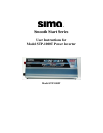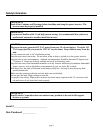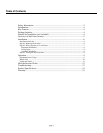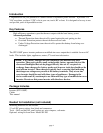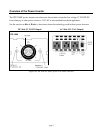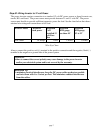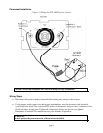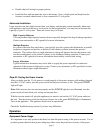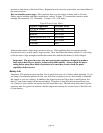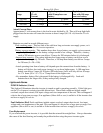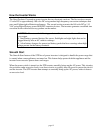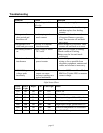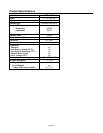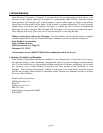
Battery Life Chart
Power
Usage
Approximate
12 volt
Current
Typical operation time
with 50 amp-hour car
battery
Typical operation
time with 100 amp-
hour car battery
100 watt 9 Amps 5.5 hours 11 hours
200 watt 19 Amps 2.6 hours 5.2 hours
500 watt 47 Amps 1 hour 2 hours
Actual Current Draw
Approximate 12 volt current draw is the load in watts divided by 10. Thus a 60 watt light bulb
plugged into the inverter will cause the inverter to draw 6 amps (60 / 10 = 6) from the 12 volt
supply.
Batteries are rated in several different ways:
Peak cranking amps
- This has little to do with how long an inverter can supply power, so it
is not a useful number for inverter operation.
Battery reserve capacity
- This number shows how long a battery can supply a given current,
typically 25 amps, before the battery voltage reaches a low voltage. Therefore, a battery
rated at 200 minutes reserve can deliver 25 amps for 200 minutes before it is discharged.
Ampere-hour capacity - This rating indicates how many amps a battery can deliver over a
period of time, typically 20 hours. Therefore, a 100 amp-hour battery can deliver 5 amps
for 20 hours (5 x 20 = 100).
Actual operating time from a battery will depend upon the current draw from the battery. A
battery will deliver less total power (energy) as you draw higher amps. A 100 amp-hour
battery can deliver 5 amps for 20 hours (100 amp-hours) but it will only deliver 50 amps
for 1 ½ hours (50 x 1.5 = 75) or 75 amp-hours at the higher rate.
Also remember, battery life is decreased if the battery is discharged fully. Lead acid
batteries have the longest life, if they are kept fully charged.
Lights and Alarms
POWER Indicator (Green)
This light will illuminate when the inverter is turned on and is operating normally. If this light goes
out the 12 volt power is missing (possible blown fuse). These fault conditions include output
overload, output short circuit, low input voltage and over temperature of the unit. This can happen if
a device has a large turn on surge, if an appliance (like a drill or saw) is stalled or if the inverter does
not have a supply of cool air.
Fault Indicator (Red) Fault conditions include output overload, output short circuit, low input
voltage and over temperature of the unit. This can happen if a device has a large turn on surge, if an
appliance (like a drill or saw) is stalled or if the inverter does not have a supply of cool air.
Fuse Replacement
If you overload the power inverter, it is possible that the external fuse might blow. Always determine
the cause of the fuse blowing and remedy the problem before using the power inverter again.
page 11



